
Where to look for inspiration, how to build a process between teams, which mechanics to choose, and how to achieve a WOW effect, says Dmitry Aborilov, game designer at Banzai Games.
Did you face the challenge of making the final boss of the game?
So that he will be remembered for a long time by a multi-million audience of fans?
Me not. But when he first came to the studio of Banzai Games , it turned out that such a task would soon be. And, listening to the inner voice, I realized that I really want to do it. And make it cool.
Ahead was the penultimate chapter and her three bosses. They could be experimented with and sorted out - exactly how the process is built in the studio, what mechanics go to the players and how to cope with the task. There will be an article about this experience.
About the game
Shadow Fight 3 is a fighting RPG that was released a year ago and has over 80 million installations. Create a character, choose his weapon, armor and fight. The game has a strong emphasis on the plot, where the player gets to know the heroes, reads dialogs and fights with various opponents. After the battle, various rewards drop out: new armor, weapons and additional abilities.
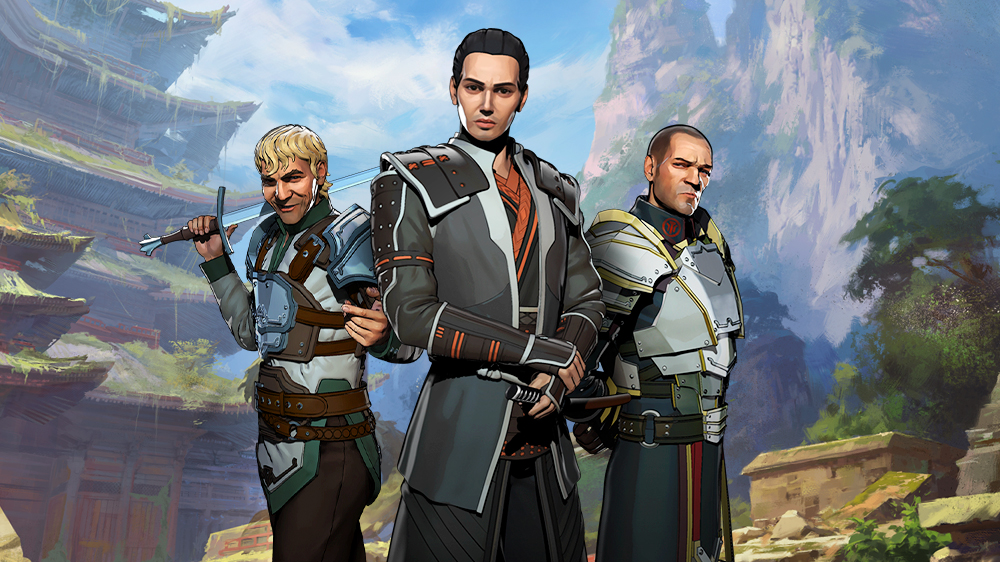
How does boss work begin?
Not really with game design. At least with us. The first thing that is done is the plot. Scriptwriters come up with enemies, their role in the world, exposure, and only then the State Duma connects.
In fact, the task of the game designer is to take the basis (appearance, character, reason for the battle) and cover everything with mechanics. There is a close interaction with all other departments - animators, artists, FX'ers, builders and programmers.
It is important to pull ideas and requirements into one solid and living thing. Of course, all this creates a lot of meetings and brainstorms. But then the result is thought out from different points of view.
But for the discussions to be effective, one must think in advance. Therefore, I took up the analysis of bosses from other games and constantly pulled all the drafts from the scriptwriters. This gave additional thinking time, and also made it possible to better understand what kind of idea and emotion would need to be revealed in the enemy.
What are the bosses in fighting games
Usually these are opponents with an increased amount of health, great damage and unique tricks. Often they have an interesting appearance, and even a good plot strapping. What makes a cool boss really cool? Why will they remember him?
I asked my colleagues to list the best bosses in Shadow Fight 3, plus I looked for mentions on YouTube. As a result, three stood out, whom almost everyone called: Gizmo, Sergeant and Itu.
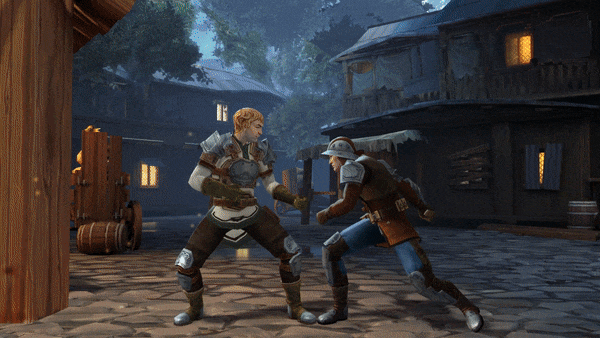
Why are they remembered? Of course, they often met in the story, and the game has already driven their images into the player’s mind. But I'm interested in something else: what are their features in the gameplay?
We write out the mechanics:
Gizmo . He fights with the help of a two-handed sword, which during the battle throws out and goes into hand-to-hand combat. The player must learn to fight against the sword, and against the fists.
Sergeant. From time to time it includes complete invulnerability and goes forward. The player must be able to avoid a collision, otherwise the boss will hold a dangerous super-reception.
Itu . When there is little health - sits down to heal. To bring down the healer, the player needs to go behind his back and hit. If this is not done, then Itu will fully recover.
All these bosses have one thing in common - they change the gameplay. They do not just have a super reception or their own unique punch. They change the state of battle - at first there was one opponent, and then became another.
Moreover, Sergeant and Itu have a built-in puzzle. If it is not solved, then the boss will not pass. This condition guarantees a memorable gaming experience, as it differs in its essence. But not the fact that this experience will be enjoyable.
It is extremely important to make a puzzle that is understandable to the target audience and can be solved without guides. And then you get a dissonance - the player wants to beat the muzzle, and he is forced to play chess ... and often hiding some of the rules.
When it came to understanding what the players liked, the required points were written out, which I want to lay in the bosses:
- puzzle
- round difficulty increase
- image integrity and mechanic
Beginning of discussions
I don’t want to go deep into the details of endless conversations, brain storms, disputes and alterations of the concept. This is a rather difficult period, since in most cases each specialist sees his part better than the whole image. Therefore, it is necessary to tell a lot, and more importantly, to say the vision so that everyone has the same idea.
In addition, when working on such significant elements of the game as bosses, ego often manifests itself - I want to add something of my own, and not just “get into credits”. But everything is decided by a sincere attitude and a desire to do better.
It is important that before the start of development it was necessary to come up with three bosses at once: Xander, the Queen and the Shadow Mind. Why is that? It is more convenient for content teams (animators, artists, FX'ers, and many others) to work when everything is planned in advance. Therefore, it was impossible to experiment on one boss and take into account the experience in the next. It was necessary to plow three concepts at once.

Xander
The first boss, Xander, was originally well described. He met the players before, but was a “loser fighter”. After his defeat, he spent a lot of time studying various martial arts. And now I'm ready to give a fight.
The best way to uncover such an idea is to give the boss several types of weapons at once. Why invent something, if you can just show how he fights with a variety of things. So he had a staff, a sword and sais.
In order for him to really start to fight them, all he had to do was choose the right shots for each of the styles (three fractions and three fighting styles in the game) and put everything together. There is a bit of balance magic here. In order for the boss to play more interestingly, strokes were selected at different distances. The staff beat on the far, the sais on the near, but the sword covered the middle.
Is this feature enough for a good boss? Partly yes. It will definitely be remembered for its uniqueness, it can be made difficult ... but it will not be a puzzle, it will not be new. What before the player fought against these styles, what now. Only the complexity has changed. Therefore, we had to think further.
Search for inspiration
In order to come up with a mechanic that will suit the boss well and create a puzzle, you need to dig into the plot, ENT and everything that has already been done. We were lucky - the scriptwriters suggested an interesting clue: it turns out, Xander refused the shadow energy!
Shadow energy is magic in the world of Shadow Fight and, at the same time, is a comeback mechanic that allows you to turn a losing situation in your favor. Something like X-Ray from Mortal Kombat's. When you are beaten, you get some energy. With full energy, you can apply extremely effective special techniques. But since Xander refused it, it means that we have an unnecessary interface element that can be used for new purposes.
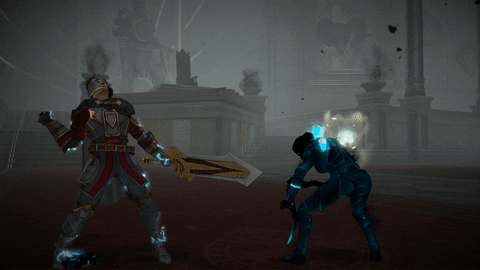
By character, the hero is quick-tempered, hating the player. And the fight takes place in prison. Therefore, I wanted to create a mechanics associated with aggression, unrestrained power and danger. This feeling gave rise to the thought: let's make a boss with two states - ordinary and crazy, when he falls into a battle frenzy.
Two states
After a little thought, they put this idea into the mechanics of rage. Every time you hit the boss, he gets a little rage that burns out over time. If you make a combination of strokes, then the rage will be a full bar, and the boss will enter into a form of rabies. And there is already an increase in damage, and unwaveringness (received blows do not interrupt the boss’s attacks), and the ability to attack the player more impudently.

Such mechanics are great for Xander (she was thought up on the basis of his image), and also changes the playlist dramatically. If a player decides to beat the boss with a bunch of punches, then Xander will go mad and tear the player apart. You have to beat him gently, one or two hits at a time.
Player emotion
Rage came out cool - it really made you think and allowed you to play with the boss. But on the playtests, an interesting conclusion was reached: when the boss broke out in flames, the players wanted to fight until they lost their pulse. To be just as evil, bright and aggressive.

But in the current implementation, it was an extremely useless activity - Xander in a rage received good protection from damage. It was added to emphasize the erroneous actions of the player. But after the tests, it became clear that the protection should be removed. She spoils the impression.
How to make a condition dangerous if there is no more protection? What makes you afraid of his rabies? The increase in damage did not help much, the boss did not become much more dangerous from this. Something stronger was needed.

We added the setting that in a rage the boss more often tries to apply this technique. And all at once fell into place. Now it’s really better not to make Xander angry - otherwise he will not only catch fire and get all sorts of bonuses, he can also kill him in one go.
Players have a choice. Now it was possible not only to pass neatly, but also to take risks — to go into battle, into the flames. It turned out to give the right emotion.
Finish line
According to the initial checklist, we made two points out of three - there is a puzzle, there is the integrity of the gameplay and plot. But in order to get through the boss, you need to defeat him in three rounds. And playing three times at the same time is also quite boring. It was necessary to add a progression of difficulty in the rounds.
We decided to make the simplest possible complication - with each round, the player needs to deal fewer hits to enter the boss into a rage. Technically, we needed the boss to go mad with 70% rage in the second round, and 50% in the third. But just changing the numbers is not interesting and not transparent for the player. Therefore, it was decided to beat the complication.
We added two animations where Xander hits himself and gets extra rage. So in the second round, when he had 70% of rage, he began to beat himself with a staff on the forehead in order to get angry and gain 100%. And in the third round, when gaining 50%, Xander stuck the sai in his leg and screaming from the surging rage - went into a rage.
The decision came by itself when the animators completed a unique superprize, where Xander hits all kinds of weapons in turn. Since there are many blows, there is a lot of damage. And if the reception in the normal state took down ~ 30% of the player’s health, then more than 60% is furious. And this is often fatal for a player.

It turned out that we actually shortened the progress bar, but made it a memorable and character-conveying animation of the hero.
Summary
I like what happened. It was possible to immediately make all the elements of our checklist:
- dock plot, visual and gameplay components;
- implement the mechanics of rage, which adds a puzzle element to the fight;
- make a progression of complexity in rounds, changing not only numbers, but also adding new catchy mechanics-animations.
Why did this happen? The original wording of the requirements + hard focus on the plot. These two points made it possible not to lose the image in search of cooler ideas and not to quarrel when discussing all sorts of points.
Separately, I want to note that the mechanics of rage are controlled by the player, not the game. One could do “the boss enrages when he has 30% of his health”. This would work, but the player could not play with the mechanics. He would have nothing to study and there would be no point in experimenting.
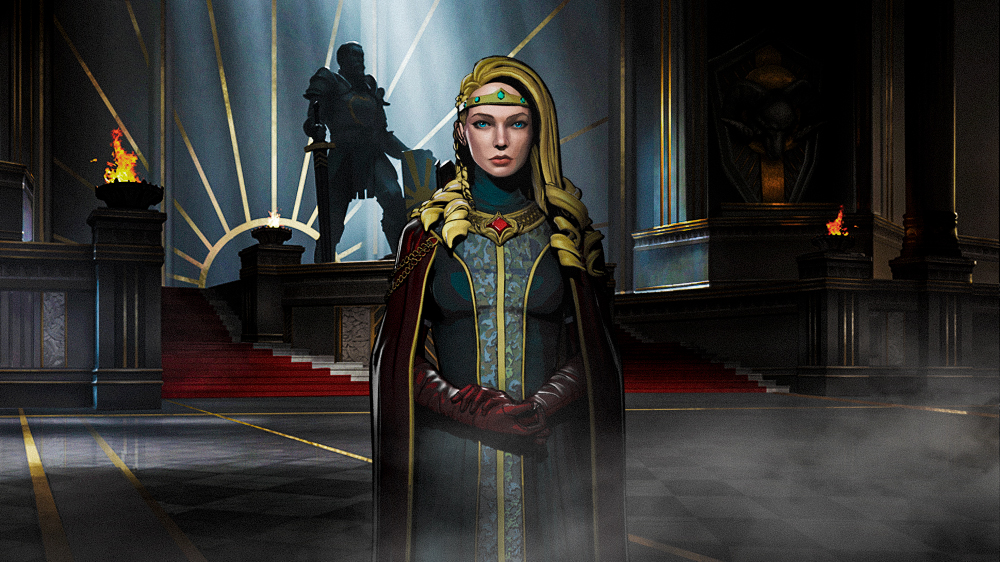
Queen Yolanda
With the second boss, everything was much more complicated. More precisely, not so - it was sad, hard, and long with him. The main problem was not seen. The scriptwriters well represented the other two bosses, but the queen hung. Therefore, I had to invent it according to a very short description: a robot girl.
Is this enough to come up with mechanics? Yes and no. The brain immediately begins to draw images from Ghost in the Shell, all kinds of augmentations, but because of this it is easy to fly away into a fantasy that has nothing to do with the game.
We had to stop, think about what conclusions can be drawn from the given description, and try to find something that is most suitable for any implementation.
Search mechanic
How to show that this is not a person, but a robot that pretends to be a person? I think the easiest thing to do is remove the parts. This is a classic - a robot can remove his hand and put something else. Well, or just tear it off, and something even more dangerous will come out of it.
Immediately there is a whole scattering of ideas:
- tricks where arms / legs are fired
- the ability to exist without body parts
- interchangeable body parts
- repairs
- wires, bombs, falling off arms / legs
And a bunch of all kinds of interesting things. But you can only do this with a small number of mechanics (team resources are limited), and the final image should not fall apart when combined with the rest of the game.
Therefore, only two mechanics were chosen - super techniques with collapsible arms / legs and repair. The latter has undergone so many changes that I don’t even remember how he thought in the original. In any case, he was responsible for changing the player’s playlist.

Repairs
In contrast to Xander, who was better off not angry, he wanted to make a character who needed to be drowned by the number of strokes. To make this the only right behavior. This is where the idea of repair mechanics came about.
The boss is given a heal, which turns on a couple of seconds after the last missed strike. So he cannot be killed if left alone. The mechanics were easy to assemble, and she immediately began to live and demand a certain behavior from the player.
But in this form, she had one big problem - it is difficult to balance. If the healer is weak, then the mechanics do not work, and if strong, then the player will have to kill the boss in one single combination. And this is virtually impossible, and in any case bad. The boss fight must be long enough so that there is a feeling of more tension than usual.
It was necessary to somehow separate the heal. Save intermediate results to the player if he has done everything correctly. So the repair crashed into three “batteries” that are mounted on the back of the boss.
Each battery heals only its own health segment: the first from 25% to 50%, the second from 50% to 75%, the third from 75% to 100%. If the boss’s health falls below the operating range of the battery, then it falls off. For example, if a player caused only 15% of the damage, then the battery will exhaust it up to 100%. But if the player was able to inflict as much as 25%, then the battery will break, and the boss will never restore health above 75%.
The mechanics themselves are not very remarkable, but they cope with their main tasks:
- conveys the spirit of robotics. Moreover, the fact that there are three batteries at once makes the mechanics even more suitable. A sort of pile of technologies;
- generates a puzzle. The player needs to look for the most powerful combinations or hope for a random critical hit that will cause a lot of damage, since the standard exchange of blows is no longer effective;
- it is convenient to balance, since the mechanics are divided into separate pieces. In fact, there is even a slight difference in the speed of the heal of the batteries, to kill the last battery was a bit more difficult. But the difference is hidden from the player and is only ~ 10%.
Super kicks
With them, everything is easier. We have a very cool team of animators who can discreetly pick up tasks for tricks and do them. And to make it really cool.
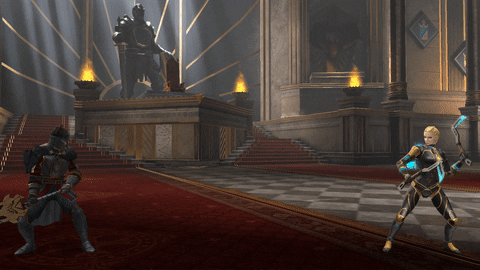
Here also happened. The only thing that was in the initial requirements was that the strikes should be very effective and work at different distances - medium and long. As a result, after a couple of weeks I was invited to watch the intermediate results, and there the robot was already starting to show its arsenal of super-tricks.
Why were there such requirements?
- Reducing the effectiveness of strikes is easier than increasing. Therefore, if you first make an imbalance in favor of the boss - it will be quickly corrected. And immediately ideal is impossible to do in principle, therefore it is better not to count;
- The difference in distance is needed so that the blows do not interfere with each other. And the player will be confused when he realizes that the boss is doing the same gameplay, but visually - different.
Round Progress
The mechanics began to live, it only remained to collect everything into a complete picture and add complications. From round to round, it was planned to include new super tricks. So it turned out the following scheme:
- Batteries
- Batteries + Medium Range Reception
- Batteries + Long Range Reception + Long Range Reception
Unexpectedly, but such a banal method of complication gave a very interesting result. Players could calmly understand the basic mechanics for the first round, and then each next solve a new puzzle and look for other ways to win. The boss simply did not give them the opportunity to continue to adhere to the tactics of the previous round.
Especially went to players with long weapons. They played calmly for two rounds, but in the third, Queen Yolanda became an extremely dangerous rival. And to pass the boss, you need to win in just three rounds.

Summary
Here, too, it turned out plus or minus to close the entire checklist. But the most important thing that I realized for working on this boss is that a clear concept is always needed. Otherwise, everyone will generate cosmic ideas, which are then difficult to use. Need an anchor.
One must go from limitations. If there is only a short wording, work only with it. If possible, come up with your own terms and apply them to the whole team.
From a less traumatic experience - it turned out that you can do cool with only one special trick. But you need to initially understand their purpose well and balance the logic of their launch quite a bit, and the techniques themselves too.
Batteries seem to me the weakest part of the boss, as they do not change the gameplay very much. It would be worth experimenting with their different amounts a little longer. Plus, they actually do not create unique situations. They tell the player “do like this - the rest is wrong” and that’s it. I think it’s much better when the mechanics allow you to go through it in different ways and get different stories.
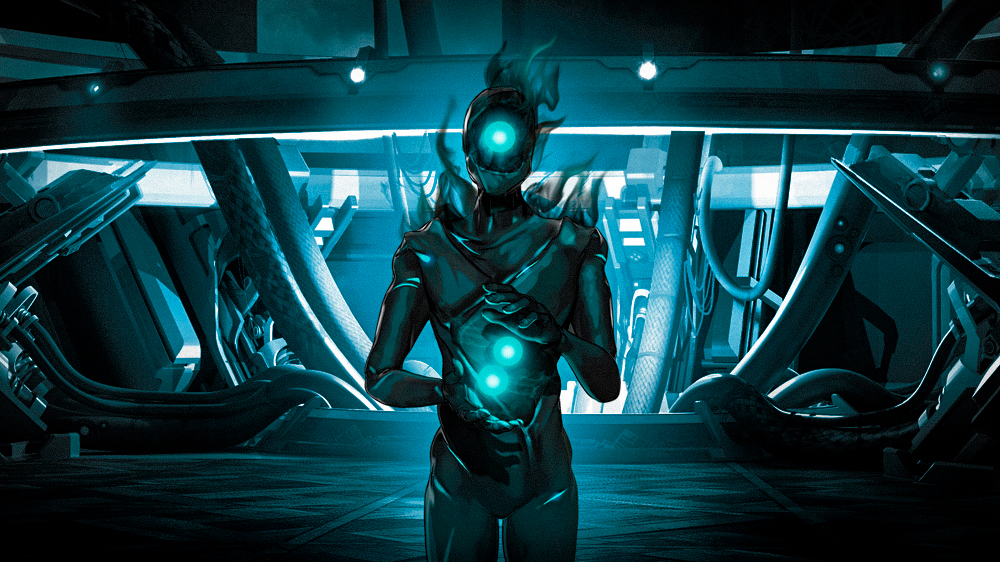
Shadow Mind
The last boss of the chapter should be the coolest. This is his calling. And if you consider that this is the penultimate chapter, and before the release of the final game, quite a lot of time will pass, you need to do something super awesome. So that every player wants to go through it, see and tell about him. And play on, of course!
On the other hand, the Shadow Mind is our last opportunity to practice before the final. Of course, there will be more bosses, but it will be necessary to invent and develop all the final ones at the same time. Therefore, you need to experiment right here and now.
To ensure that the boss is guaranteed to be remembered and stood out against the background of the previous two, you need some stunning visuals. Therefore, in the original checklist laid a very simple point: wow-effect. How to do it is not so important, the main thing was to immediately set out to surprise the players.
Wow
The search for the mechanic, as always, began with a plot and a lore substantiation. Shadow Mind has long been in the game. He can get into the consciousness of many characters and exist there. The battle with him takes place in something like a “hall of reason” of the player, where, of course, the boss has full power - this is his habitat.
The first thing that comes to mind when talking about a deity is all sorts of natural disasters. After all, this is in its purest form a demonstration of power unknown to man. Therefore, there was an idea - let the boss throw all sorts of shadow tornadoes, typhoons and all that into the player. This is definitely WOW - as everything will be huge, dangerous and unusual.
The idea came to everyone, but immediately pulled difficulties. For example, in the available locations it was impossible to show something huge. The camera is close to the characters, so the typhoon just does not fit, and you can’t move it away. The borders of the world and various auxiliary elements that were hidden from the player will immediately come out.
Therefore, we decided to make no less endless location - a bridge that does not start anywhere and does not end anywhere. Players could always go in any direction, well, or take off infinitely high. This made it possible to forget all potential problems with the camera in the future and provided truly unlimited possibilities for HUGE EFFECTS.

The second problem was outlined in the balance of such typhoons. How much damage does it do? How to avoid the player? The answers were not very pleasant. But there was a good way - we just replaced typhoons with BulletHell - the mechanics when thousands of all kinds of killers fly, and the player needs to dodge them.
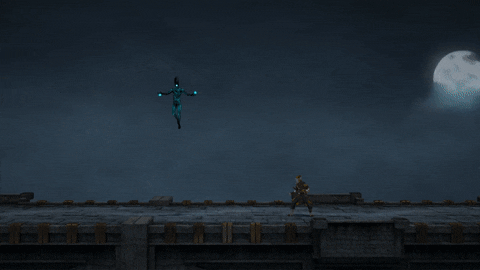
So it was possible to show something huge, but not from one large element, but from many small ones. It turned out that the damage will be small and can be avoided by hiding in the right place.
To finally finish off the WOW effect, we decided to make some kind of super punch where the boss throws the player a great distance and flies after him. It would turn out something like an epic super-heroic device, and at the same time a demonstration of the infinity of the map. But when the animators took up the reception, it turned out to be a huge cartoon with a bunch of strokes, take-offs and other things. I even had to do dishonestly low damage from the reception, because if correctly calculated, he would kill the player with full health.
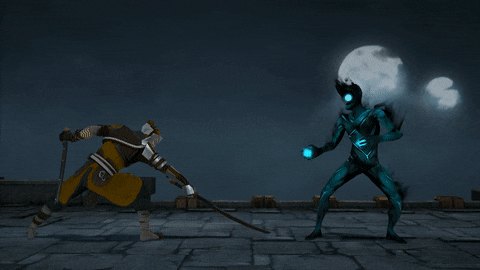
Puzzle
Visual expressiveness is very cool. But bullethell does not make the boss a puzzle. Of course, the player will have to remember exactly where to stand and how to move so that he is not hooked. But this is something like a mini-game, not a full-fledged mechanics. I wanted to add a more complex element.
Shadow Mind is constantly in shadow form and fights in the halls of the player’s mind. It is logical to assume that the laws of the world should differ from the usual ones. Not every time you fight in your own head.
The simplest mechanics suggested itself: what if a player inflicts damage on the boss only when he himself is in shadow form? It turns out that in order to interact with the “shadow world” one must enter into a shadow state related to the world. In my opinion, it sounds logical.
It remains only to develop the idea. I wanted the battle to be of two phases that are constantly changing - the player in the normal state and the player in the shadow form. But for this to happen often, you need to give the player a lot of shadow energy, since under normal conditions a full bar of shadow shadow will barely accumulate by the end of the round.
This edit was easy to do. We added a little mechanics: every time a player hits a boss, he gets a lot of shadow. So it made sense to fight with the boss in the usual form and instantly use shadow tricks - when the scale was full. The fight was rigidly divided into two states that constantly replaced each other.
By the way, an unexpected additional result came from the new mechanics - now that the player was in shadow form, he could extend it by hitting the boss. So in certain cases it was possible to fight almost twice as long as in ordinary battles. Such a reward for the right actions was very well integrated into the overall concept.
The final touch of mechanics is the reduction in damage from boss hits and player’s shadow hits. This was a necessary rebalance, so that the battle did not last 1-2 shadow forms, but 3-5 transitions. As a result, after several hours of tsiferka tsiferka battle became really a “shadow war” and felt extremely cool, even without bullethell and other WOW-pieces.
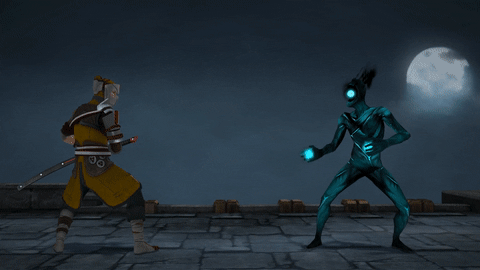
Round Progress
It remains to tighten the increase in complexity, and the boss is finished. For the Shadow Mind, this stage was the most understandable of all. Firstly, you can simply complicate bullethelles from round to round, and secondly, reduce the cooldown on the use of shadow abilities.
The trick is that shadow abilities are hard to counter. Therefore, it could be said that the boss will kill the player in ~ 8 uses. And consequently, if the cooldown for use is 6 seconds, the player will lose if the boss does not pass in ~ 1 minute (taking into account the time of use). Therefore, we simply reduced this cooldown from round to round and received an increasingly complex and dynamic test.
Summary
Most importantly, the WOW effect has reached the players. Almost all videos with the passage of the sixth chapter of Shadow Fight 3 on the preview is a screenshot of the bullethell. The players were thrilled! There were no flights, endless locations in the game, and no one threw a bunch of shells from the sky. Once again, everyone in the studio felt what immense power the visual has in games.
Although, of course, the price of the effect was high. It’s hard to do what no one has ever done in a project. And even harder is to make it playable. Fighting mechanics does not provide opportunities for evading a pile of bullets flying from the sky. The problems that arose during development were many.
The puzzle worked. Players began to share the most effective builds, which gave bonuses from entering the shadow form or increased damage in it. This is cool - it means this boss has created a new plane for the game.
But not without a sad moment. Some players thought that the boss was simply much higher in level, and therefore they did so little damage that it was not displayed in the interface. This situation often arises in ordinary battles in Shadow Fight 3, but at the development stage we missed this point.
I had to make a special fix - to close the boss’s health scale with a beautiful effect when the player is outside the shadow form. So the players did not have the opportunity to lose sight of the mechanics.
Conclusion
Now we are already quite far from that chapter (at the time of writing, the final boss of the game is already in production). But there are a number of points that I have identified for myself and are still using:
- To quickly and efficiently come up with, you need a concept. If it is not, you need support words, conditions and any other anchors that will keep the imagination within. Thus, three points are achieved at once - it is easier to work, a more holistic concept is obtained, and it is much easier to accept or reject ideas.
- The WOW effect is crucial. There is no point in the boss, which is interestingly passed, but does not cause surprise and is not remembered. It is necessary that everything was at once - and an awesome visual, and interesting mechanics.
- You need to lay the puzzle element and progress in the rounds right away. If there is a suspicion that somewhere the mechanics are not well thought out, then most likely this is really so.
- While there is not even a rough understanding of how to twist numbers to make the mechanics work, you do not need to believe in it. Perhaps it is worth thinking more or even changing the concept. With Queen Yolanda, we managed to make a good boss, but this is more likely luck and a few sleepless nights during the build-setup.
- Make friends with the team. She can do cooler than what you imagine. But for this you need to make sure that you are understood correctly. . — , -. , , . .
Banzai Games -. .